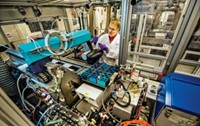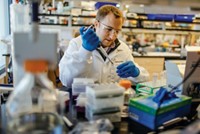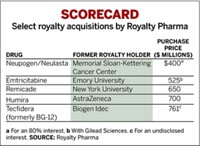Advertisement
Grab your lab coat. Let's get started
Welcome!
Welcome!
Create an account below to get 6 C&EN articles per month, receive newsletters and more - all free.
It seems this is your first time logging in online. Please enter the following information to continue.
As an ACS member you automatically get access to this site. All we need is few more details to create your reading experience.
Not you? Sign in with a different account.
Not you? Sign in with a different account.
ERROR 1
ERROR 1
ERROR 2
ERROR 2
ERROR 2
ERROR 2
ERROR 2
Password and Confirm password must match.
If you have an ACS member number, please enter it here so we can link this account to your membership. (optional)
ERROR 2
ACS values your privacy. By submitting your information, you are gaining access to C&EN and subscribing to our weekly newsletter. We use the information you provide to make your reading experience better, and we will never sell your data to third party members.
Business
Betting on the Right Drug
Instead of investing in companies, Symphony Capital finances drug candidates that meet strict criteria
by Lisa M. Jarvis
May 26, 2008
| A version of this story appeared in
Volume 86, Issue 21
FUNDING CONSTRAINTS are the downfall of many small biotechnology companies. These firms usually live hand-to-mouth, with their next windfall—a payment from a licensing partner or a jump in stock price—linked to reaching milestones in the development of a product. As a result, the quality of their clinical trials is often dictated by how much, or how little, they can afford until that next infusion of cash. That route often leads directly to a failed trial.
The New York City-based private equity firm Symphony Capital is trying to interrupt that cycle. The fund's investors believe they have found an inflection point in the drug development cycle where they can get the highest return for the lowest risk, yet also help a biotech firm shepherd its precious assets along a more rational development path.
Rather than simply meting out cash for results, Symphony forms a separate company with its partners and then invests a lump sum in specific drug candidates. The biotech firm has the option to buy back the drugs at any time for an agreed-upon price. If it doesn't choose to buy them back, the drugs revert to Symphony. Thus, both companies have a vested interest in the products' success.
Harri V. Taranto, cofounder and managing director of Symphony, points to clinical trials where having 150 patients rather than 100 might have been the difference between proving that a drug works and failure of the trial. "There are lots of underpowered studies out there, and we are trying to avoid that," he says.
Symphony antes up at the very start of the collaboration, giving partners the money to plan a solid clinical development program. "The key is to design the best trial and then make sure you have the funding in place to complete it," Taranto says. "We commit the funding up front, so companies don't have annual, or even quarterly, changes in cash position forcing them to redesign a trial or take shortcuts."
Such financial stability can have a transformative effect on a company. Frank Karbe, chief financial officer at Exelixis, which formed a collaboration with Symphony in 2005, says his company couldn't have built such a robust pipeline of oncology drugs without significant financial resources. The transaction with Symphony "helped us finance more extensive clinical trials for several of our compounds, thereby substantially increasing our chances of success," Karbe says. "At the same time, we were able to transfer the financial risk of failure to Symphony, minimize dilution to our shareholders, and retain future partnering opportunities."
Yet the universe of companies that can tap into Symphony's coffers is small. The investors are interested only in companies that are innovators in their particular field and that can contribute at least two drug candidates to the new company that will be created with Symphony. The products should be in different therapeutic areas and be between preclinical development and early Phase II trials, in which a drug's biological activity is tested. The rationale is that if one drug fails, the partners at least have a chance to recoup the investment on the second product.
The compounds should also be critical to the future value of the biotech company. In other words, they should be something the firm would want back someday. If the biotech firm decides not to buy back its drug candidates, Symphony is left holding the bag.
"If you put all of that together, at any given time there are relatively few companies that fit our model," Taranto says. He estimates that about 300 companies meet those criteria. Each year, Symphony talks to roughly 150 of them in discussions that could span from merely touching base with a company that is interesting but not yet ripe for investment, to initiating a formal meeting that could lead to collaboration. Overall, the investors try to establish pacts with just two or three companies a year.
The firm's biggest competition is big pharma. For a biotech company, a deal with a big drugmaker is still considered the ultimate validation, although Taranto says he thinks Symphony is starting to challenge that notion. And to date, he can recall losing out to big pharma on just two deals.
Although Symphony's universe is relatively small, the firm still must sift through a lot of science to determine which companies truly offer unique and robust technology. In setting up a deal, Symphony assesses whether the science is strong enough to support the indication the company is pursuing and whether the safety data are adequate for that indication, says Alastair J. J. Wood, a managing director at Symphony.
TO CONDUCT the assessment, the team taps into internal expertise that spans academia and industry. For example, Wood, a clinical pharmacologist, is the former associate dean at Vanderbilt University's School of Medicine. He served on Food & Drug Administration advisory committees and was the drug therapy editor for the New England Journal of Medicine.
Taranto worked as a consultant to the biotech industry, starting in the early 1980s as one of the cofounders of the Wilkerson Group, a life sciences strategy consulting firm. Together with the experience of their other partners, Taranto and Wood say they can get a good feel for the scientific, clinical, regulatory, and commercial potential of a given drug candidate. Importantly, they also have a long list of contacts to turn to when vetting the science and market potential for a particular drug.
"There are other firms that can assess what's real and what's not real, and there are a lot of firms with money," Taranto says. What differentiates Symphony, he believes, is the combination of skills and experience it brings to bear on a deal.
Symphony GenIsis, a joint venture formed in 2006 with Isis Pharmaceuticals, demonstrates how those abilities come together. Isis is a leader in antisense technology, an approach that targets the RNA that controls the production of disease-causing proteins. The antisense approach has been around for decades, but it fell out of favor after several high-profile drug failures. It seemed first-generation antisense drugs were safe but simply not potent enough to interrupt disease.
"When my partner first brought up Isis, we all rolled our eyes," Taranto says. But on second look they realized that Isis had several second-generation drugs in its pipeline. Combine that with some compelling clinical data in both diabetes and cholesterol control, and the partners decided a deal was worth pursuing. "There's nothing more powerful than an idea whose time has come," Taranto says.
Symphony GenIsis turned out to be Symphony's first success story. Carlsbad, Calif.-based Isis was able to buy back its drug candidates in just 17 months, thanks to an influx of cash from a licensing deal with Johnson & Johnson for diabetes drugs. Symphony put $75 million into the collaboration; last September, Isis agreed to buy back its products for $80.4 million in cash and 3.4 million shares of Isis stock, at the time valued at $39.6 million.
IN ADDITION to vetting a company's science, Symphony examines its development plan to gauge how long it will take for a partner to want to buy out its stake. After all, the goal is for Symphony to make a return and for the biotech company to have more leverage when negotiating with potential commercialization partners. Isis was a particularly quick turnaround; Symphony expects most biotechs will cash out in three to four years.
So far, Symphony appears to be on the right track. The first fund is nearly complete, with six collaborative companies formed and a seventh in negotiations.
The firm's first partner, Guilford Pharmaceuticals, did not buy back the drug it had contributed to Symphony Neuro Development Co. Involving only one drug—albeit one being studied across several indications—that deal was perhaps an early warning that a collaboration needs multiple candidates for it to be successful. Symphony was able to recoup some of its investment by selling the assets to GliaMed.
Time will tell whether the remaining companies will produce the kind of return that Isis offered; the three- to four-year mark is just around the corner for partners Exelixis, Dynavax Technologies, and Alexza Pharmaceuticals. In the meantime, Symphony is getting ready for its second fund. It doesn't plan to stray from what it considers a unique financing model.






Join the conversation
Contact the reporter
Submit a Letter to the Editor for publication
Engage with us on Twitter